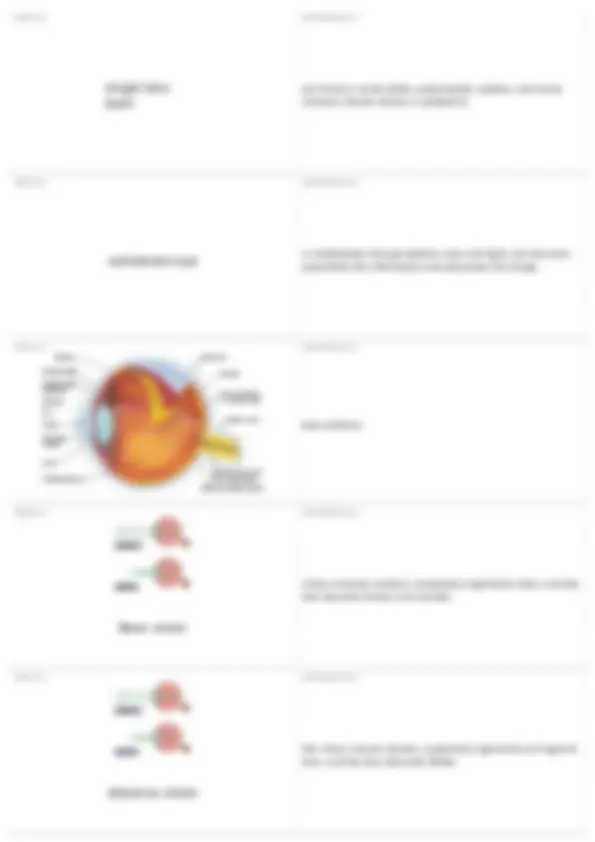








Study with the several resources on Docsity

Earn points by helping other students or get them with a premium plan


Prepare for your exams
Study with the several resources on Docsity

Earn points to download
Earn points by helping other students or get them with a premium plan
Community
Ask the community for help and clear up your study doubts
Discover the best universities in your country according to Docsity users
Free resources
Download our free guides on studying techniques, anxiety management strategies, and thesis advice from Docsity tutors
Definitions and explanations of various sensory systems, including mechanoreceptors, chemoreceptors, thermoreceptors, pain receptors, statocysts, and the lateral line system. It also covers the anatomy of the ear and the concept of equilibrium. Additionally, the document discusses the muscular system, focusing on the sliding filament model and the role of different types of muscular tissue in producing body movements and stabilizing positions.
Typology: Quizzes
1 / 12

This page cannot be seen from the preview
Don't miss anything!







is the strengthening of stimulus energy by cells in sensory pathways (vision and hearing) TERM 2
DEFINITION 2 is a decrease in responsiveness to continued stimulation TERM 3
DEFINITION 3 Mechanoreceptors (movement). Chemoreceptors (chemical tastebuds). electromagnetic receptors (light). thermo- receptors (heat).pain receptors TERM 4
DEFINITION 4 sense physical deformation caused by stimuli such as pressure, stretch motion, and sound. they range from simple naked dendrites to complex structures in the ear. detect moving fluid or settling particles TERM 5
DEFINITION 5 transmit information about the total solute concentration of a solution, specific ones bind to individual kinds of molecules. this binding changes the chemoreceptor ion permeability
respond to heat or cold help regulate body temperature. TERM 7
DEFINITION 7 are naked dendrites in the epidermis, respond to excess hear, pressure or chemicals released from damaged or inflamed tissue TERM 8
DEFINITION 8 most invertebrates maintain equilibrium using sensory organs called statocysts. TERM 9
DEFINITION 9 statocysts contain mechanoreceptors that detect the movement of granules called statoliths TERM 10 DEFINITION 10 anatomy of an ear
in aquatic animals there is no distinction between taste and smell. taste receptors of insects are in sensory hairs called sensilla, located on feet and in mouth parts. TERM 17
DEFINITION 17 receptor cells are modified epithelial cells organized in to taste buds. there are five taste perceptions; sweet, sour, salty, bitter, and umami (savory) taste can be detected anywhere on tongue TERM 18
DEFINITION 18 olfactory receptor cells are neurons that line the upper portion of the nasal cavity TERM 19
DEFINITION 19 simplest is eye cup of planarians, which detects light intensity and direction TERM 20
DEFINITION 20 are found in insects and crustaceans and consist of up to several thousand light detectors called ommatidia (effective at detecting movement)
are found in some jellies, polychaetes, spiders, and many molluscs (found mainly in predators) TERM 22
DEFINITION 22 in vertebrates the eye detects color and light, but the brain assembles the information and perceives the image. TERM 23 DEFINITION 23 eye anatomy TERM 24
DEFINITION 24 ciliary muscles contract, suspensory ligaments relax, and the lens become thicker and rounder TERM 25
DEFINITION 25 the ciliary muscle relaxes, suspensory ligaments pull against lens, and the lens becomes flatter
in rods and cones the receptor potential is a hyperpolarization TERM 32
DEFINITION 32 contributes to information processing in the retina, it receives signals from rods and cones TERM 33
DEFINITION 33 contributes to information processing in the retina. it transmits signals from bipolar cells to the brain TERM 34
DEFINITION 34 horizontal cells and amacrine cells help integrate visual information TERM 35
DEFINITION 35 contributes to information processing in the retina. interaction among different cells results in lateral inhibition, a greater contrast in image.
visual pathways TERM 37
DEFINITION 37 skeletal (striated, cardiac intercalated discs, and smooth (pointy shape at ends) TERM 38
DEFINITION 38 -producing body movements, -stabilizing body positions, - moving substances within the body (heart muscle, digestive tract). -generating hear (shivering). TERM 39
DEFINITION 39 Tropomyosin is round around actin. Tropomyosin covers the myosin binding sites on the actin. when calcium comes, it binds to the Troponin which is attached to the tropomyosin, which exposes the myosin binding sites on the actin. TERM 40
DEFINITION 40 Action potential travels down neuron & releases acetylcholine (ACh) at neuromuscularsynapse.
skeletal muscle has limited regenerative abilities. growth of skeletal muscle after birth is due to hypertrophy TERM 47
DEFINITION 47 classified as oxidative or glycolytic fibers, by the source of ATP. -as fast-twitch or slow twitch fibers, by the speed of muscle contraction TERM 48
DEFINITION 48 glycolytic fibers is anaerobic, respiration is quick but it cant last long TERM 49
DEFINITION 49 oxidative, like running long distance as opposed to a short sprint TERM 50
DEFINITION 50 in lab printout
Syarthroses-immovableamphiarthroses- slightly moveable TERM 52
DEFINITION 52 connected by cartilage, allow more movement between bones than a fibrous joint, but less than the synovial joint TERM 53
DEFINITION 53 most moveable joint in mammals TERM 54
DEFINITION 54 hold bones together TERM 55
DEFINITION 55 First type of skeleton, means to lack hard parts